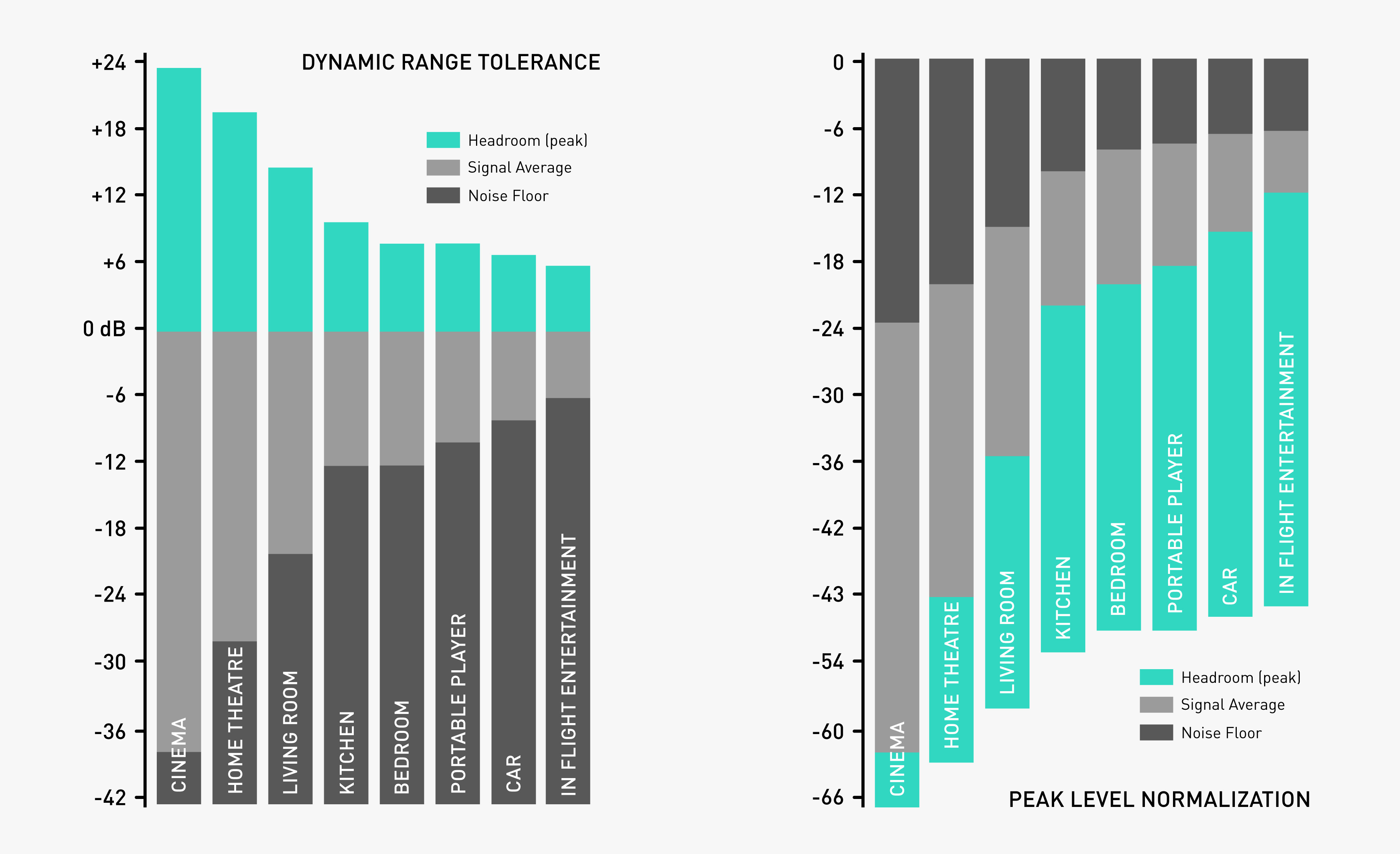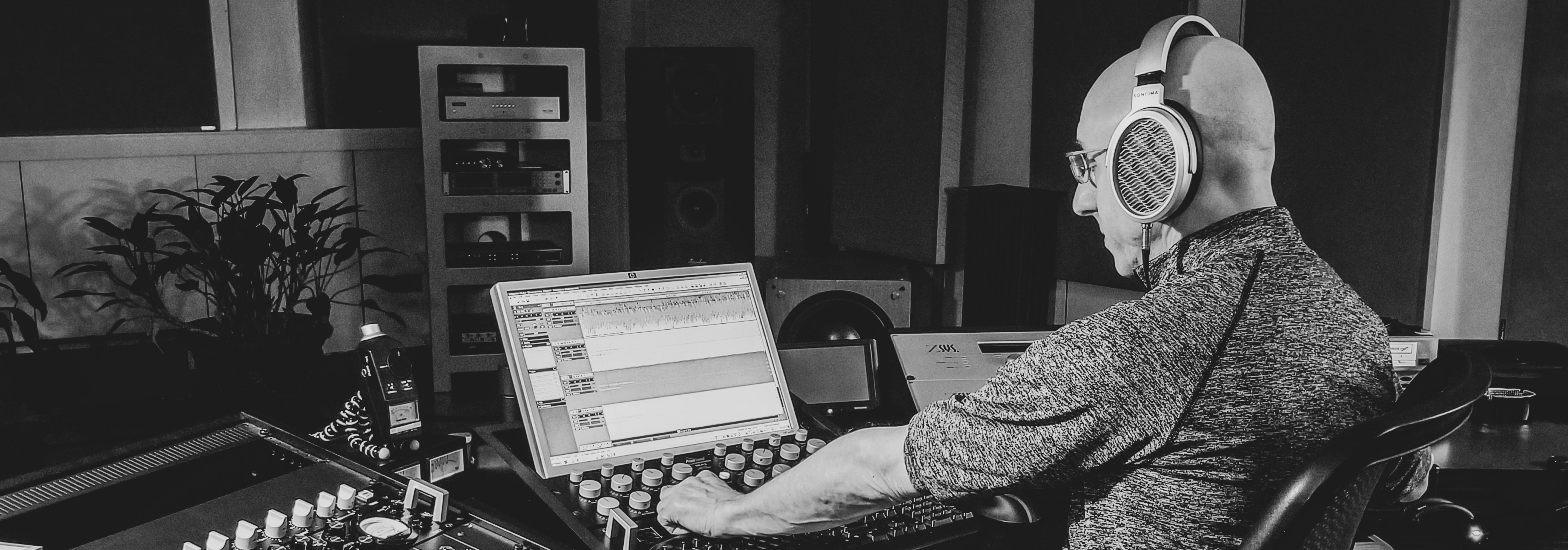May 31, 2020
No need to squeeze - Mastering for Streaming

Why music streaming could get dynamics back into mastering
"The Future of Music Production" panel from MixCon 2019 was sponsored by iZotope and featured Alan Silverman with insights on Mastering for Streaming. Let's pick up the main ingredients from his presentation for our own mastering bowl. How will dynamics come alive again?
Up until now: When everybody just wanted a hotter record
Using the graphs below, Alan explains which type of consumer format benefits from the biggest or the smallest dynamic range. You could have a cinema experience with intimate whispering and blasting gunshots, or you could listen while driving and still recognize the lyrics. Having a standardized range for different formats would usually prevent mastering engineers from squeezing dynamics too hard in any case. So why has popular music suffered the most? Not because of cars and airplanes, rest assured.
Alan tells us a story: Back in the 60s, engineers invented new methods to cut vinyl to be twice as loud as before, and everybody wanted these cuts going forward. Those records stuck out immediately compared to the rest, and so the "Loudness War" began.
When using Peak Level Normalization, for instance, radio stations used a smaller dynamic range, which resulted in a louder track. That's because peaks that were compressed would leave additional headroom for the whole signal, which in return could be pushed in level again.
Over the last few decades, music on the radio, aside from Opera or Jazz, shrunk its range down to "In-Flight Entertainment" size (see graph below.) This means that all main elements of a particular track like drums, bass, vocals, and melodies would jump right out of the speakers. On every track, every station, day and night.
In his presentation, Alan Silverman lets us hear the differences between a compressed (peak limited) and an untouched mix, all lined up in his mastering DAW Sequoia. As you can hear, it's adding ugly distortion and noise. Heavily compressed material sounds distorted at some point.

Squashing dynamics will be punished
But the story continues. Along came the Internet and with it the technology to provide media via broadband. At the dawn of streaming, producers realized two things: First - digital masters with file compression on top often suffered from sample overshoots; therefore, risking audible artifacts. So the maximum peak for videos and podcasts had to be significantly lower than 0 dBFS. Second - all masters sounded differently varying in dynamic range and, therefore, overall level. A classical symphony ripping your ears off in forte practically disappears in piano when played side by side with modern, in-your-face rock. To prevent the listener from having to adjust to these drastic level changes, there had to be a way to even out those differences. Along came traditional metering, like a VU, which is based on the average (RMS) between the lowest and highest amplitudes inside a specific time frame. But because VUs only follow changes in amplitude, newer specifications for Loudness measurements were weighted by frequency response curves of human hearing. LUFS became a standard for streaming, and all signals were matched to an average Loudness.
It became obvious that music with dynamics squashed to death sounded somewhat thin and harsh when compared to highly dynamic material.
How to prepare for streaming: Gain staging and transient impact
As Alan put it, compression and limiting are already part of popular music genres such as Hip Hop, EDM, Metal, and the like. But using it should always be an aesthetic decision rather than a competitive one. And even in those genres, more headroom is left on the mix than today's mastering would retain for release.
If your material asks for more punch and aggression, use compression to taste. But beforehand, make sure to even out level differences through automation. Balance out carefully all elements fighting for space in your mix. You can do that with fader rides, panning and EQ alone. This way, your compressors won't work too hard while still adding color. Also, try to leave transients intact using longer attack times. Drums will cut through easier and will have an audible impact when striking. Overly compressed drums tend to sound flat and weak in comparison. Last but not least try out multiple compressor types on single or group tracks, chained or in parallel mode. One to tame drastic peaks, one to even out dynamics and one for the color etc.
To keep your Loudness under control you will find standardized metering in Samplitude Pro X5 Suite and even more metering options in Sequoia 15.

Conclusion
With Alan Silverman leading the way to a better master in times of streaming others will follow. If digital distribution is going to be even larger than it already is there's no need to join the loudness race. Dynamics will be back again. A track sticks out in your playlist if it sounds good. It has an impact if transients come through. It's exciting if it varies between softer and louder parts. For a louder but more transparent listening experience please use your volume knob.
Glossary
dBFS
Is an absolute unit used to describe the sample level in the digital domain. 0 dBFS, where "FS" stands for Full Scale, is the maximum level in the digital realm before clipping abruptly.
Loudness
Is a perceptually property of sound. Humans rate loudness between quiet and loud. Is it used in Loudness Range values (LU) to compare different signals' strength in regard to frequency response curves of human hearing centering around 1 kHz.
LUFS
Unit of Loudness on an absolute scale where 0 LUFS marks the digital full scale. 1 LUFS is equivalent to 1 dB.
Normalization
Applying a fixed amount of gain to a source, a program or a music track to meet it's suitable maximum peak. Normalization may be based on loudness or peak level.
Peak
Is the highest amplitude of an audio signal wave.
RMS
Referring to methods metering a root mean square of for instance amplitude but also Loudness.
VU
Is a volume unit meter showing audio signal level averaging out peaks and troughs. Originally build as a passive electromechanical device.
References
Bob Katz - Charts on Dynamic Range Tolerance originate from his book "Mastering Audio".
Thomas Lund - Author of glossary background to loudness and metering, courtesy of TC Electronic.
Anders Øland, Roger Dannenberg - Authors of glossary background to loudness and pan laws.
SonicScoop - "The Future of Mastering: Loudness in the Age of Music Streaming" was initiated by SonicScoop editorial staff.
Wikipedia - Additional information on VU meter.
Next Post >
Transfer soundpool library
< Previous Post
Artist Interview: Oleksa Lozowchuk